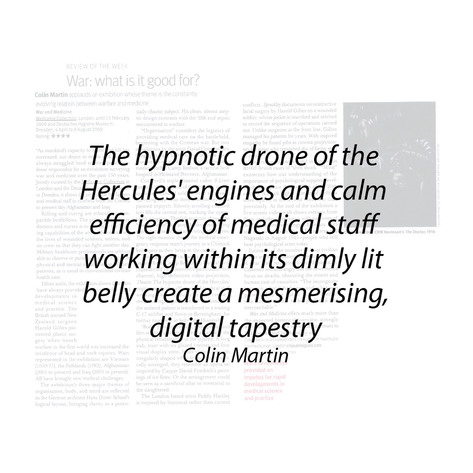British Medical Journal: War: what is it good for?
Publication Title: British Medical JournalPages: 84
Writer: Colin Martin
Publication Date: 6th December 2008
"As mankind's capacity to maim and kill has increased, our desire to repair and heal has always struggled hard to keep pace," say those responsible for an exhibition surveying war and medicine over the past 150 years. Jointly curated by the Wellcome Collection in London and the Deutsches Hygiene-Museum in Dresden, it shows the pity of war for fighters and medical staff in conflicts from the Crimea to present day Afghanistan and Iraq.
Killing and curing are ethically incompatible bedfellows. The priority of military doctors and nurses is to maintain the fighting capabilities of the armed forces, saving the lives of wounded soldiers, sailors, and air crew so that they can fight another day. Military healthcare professionals are seldom able to observe or participate in the long term physical and mental rehabilitation of their patients, as is usual in conventional civilian health care.
Ethics aside, the exhibition shows that wars have always provided an impetus for rapid developments in medical science and practice. The British trained New Zealand surgeon Harold Gillies pioneered plastic surgery when trench warfare in the first world war increased the incidence of head and neck injuries. Wars represented in the exhibition are Vietnam (1959-75), the Falklands (1982), Afghanistan (2001 to present) and Iraq (2003 to present). All have brought new medical challenges.
The exhibition's three major themes of organisation, body, and mind are reflected in the German architect Hans Dieter Schaal's logical layout, bringing clarity to a potentially chaotic subject. His clean, almost aseptic design contrasts with the filth and sepsis encountered in warfare.
"Organisation" considers the logistics of providing medical care on the battlefield, beginning with the Crimean war. But two installations by the artist David Cotterrell are bang up to date. In November 2007 he spent four weeks observing the work of military medical staff at Camp Bastion, a tactical field hospital in Helmand Province, Afghanistan. Cotterrell's triple channel video 9-Liner presents three aspects of the dramatic recovery of a wounded soldier from a forward operating base. The three monitors evoke a painted triptych. Silently scrolling codified text fills the central one, tracking the operation's progress. The left monitor shows the "watch keeper" at Camp Bastion, monitoring computer screens and answering telephones. The right monitor shows the medical emergency response team's journey in a Chinook helicopter as they bring in the casualty.
The night-time evacuation of a stabilised patient from Camp Bastion to Kandahar is represented in Cotterrell's panoramic five channel, high definition video projection, Theatre. The hypnotic drone of the Hercules' engines and calm efficiency of medical staff working within its dimly lit belly create a mesmerising, digital tapestry. At Kandahar the sedated patient is transferred to a waiting C-17 airlifter and flown to Birmingham, for further treatment at Selly Oak Hospital.
"Body" presents artefacts, photographs, and film relating to wartime medical care and the physical rehabilitation of the injured. A long slab, inset with six glazed vitrines and four visual display units, leads visitors towards irregularly shaped white forms. Asymmetrically arranged, they resemble an opera set inspired by Caspar David Friedrich's paintings of ice floes. Or the arrangement could be seen as a sacrificial altar or memorial to the slaughtered.
The London based artist Paddy Hartley is inspired by historical rather than current conflicts. Spreckley documents reconstructive facial surgery by Harold Gillies on a wounded soldier, whose jacket is inscribed and stitched to record the sequence of operations carried out. Unlike surgeons at the front line, Gillies managed his patients for years. With inspired empathy he found jobs as cinema projectionists for some who remained shy of being seen in public.
The first world war resulted in more than 80 000 British cases of "shell shock." "Mind" examines how our understanding of the importance of psychological support developed throughout the conflicts of the 20th century. A much higher number of civilians were injured in the second world war than previously. At the end of the exhibition a five screen video wall shows extracts from films, including interviews with survivors of the Dresden fire bombings in February 1945 and the atomic bombing of Hiroshima and Nagasaki in August 1945-people who still bear psychological scars today.
Estimates of the number of Iraqi civilian deaths are hotly debated in medical journals. A year after returning from Afghanistan, Cotterrell remains angry that the news media focus on deaths, obscuring the extent and human cost of casualties. "The incongruity between what I had seen and what was presented as the public face of conflict was, and continues to be, profound and irreconcilable."
War and Medicine offers much more than the expected historical overview, strongly advocating peace in a world that continues to be bereaved and burdened by war.
Colin Martin is an Independent consultant in healthcare communication, London cmpubrel@aol.com
Download this file here, or click the image on the right.Share:
Twitter / Facebook / Pinterest
